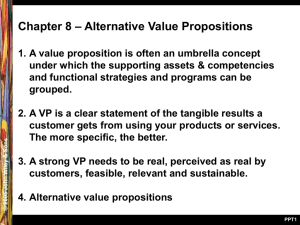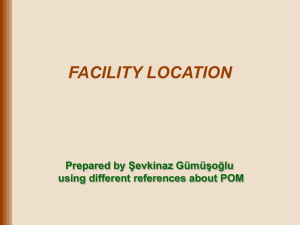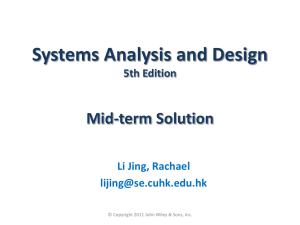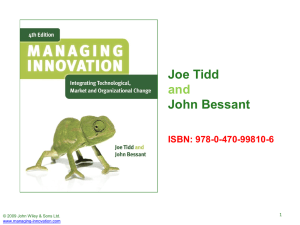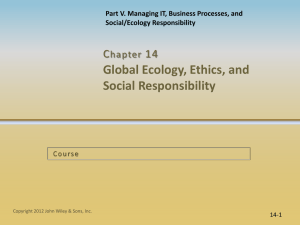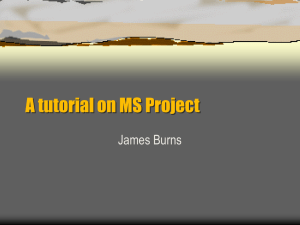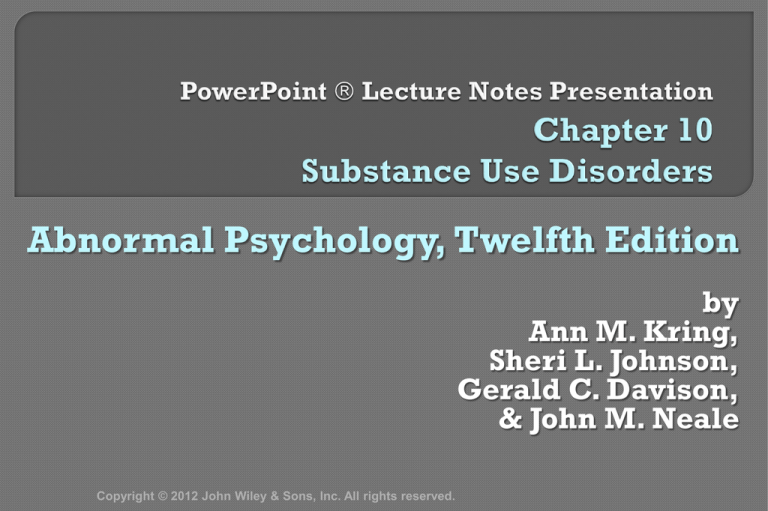
Abnormal Psychology, Twelfth Edition
by
Ann M. Kring,
Sheri L. Johnson,
Gerald C. Davison,
& John M. Neale
Copyright © 2012 John Wiley & Sons, Inc. All rights reserved.
Chapter
10: Substance Use Disorders
I. Clinical Descriptions, Prevalence, and
Effects of Substance Use Disorders
II. Etiology of Substance Use Disorders
III. Treatment of Substance Use
Disorders
© 2012 John Wiley & Sons, Inc. All rights reserved.
© 2012 John Wiley & Sons, Inc. All rights reserved.
DSM-IV-TR pathological use of substances divided into
two categories:
• Substance abuse
• Substance dependence
DSM-5 has one category:
• Substance use disorder
• Categorize by specific substance:
Alcohol
Amphetamine
Cannabis
Cocaine
Hallucinogen
Inhalant
Opioid
Phencyclidine
Sedative/hypnotic/anxiolytic
Tobacco
© 2012 John Wiley & Sons, Inc. All rights reserved.
Problematic pattern of use that impairs functioning.
Two or more symptoms within a 1 year period:
• Failure to meet obligations
• Repeated use in situations where it is physically dangerous
• Repeated relationship problems
• Continued use despite problems caused by the substance
• Tolerance
• Withdrawal
• Substance taken for a longer time or in greater amounts than intended
• Efforts to reduce or control use do not work
• Much time spent trying to obtain the substance
• Social, hobbies, or work activities given up or reduced
• Continued use despite knowing problems caused by substance
• Craving to use the substance is strong
© 2012 John Wiley & Sons, Inc. All rights reserved.
Severe substance use disorder
• Having four more severe symptoms, such as:
Tolerance
Larger doses needed; lower dosage does not produce typical effect
Withdrawal
Negative physical and psychological effects from stopping usage
Using more than intended amounts
Trying unsuccessfully to stop
Having physical or psychological problems made worse by drug
Experience problematic relationships
• With physiological dependence:
Presence of either tolerance or withdrawal
• Without physiological dependence:
Absence of either tolerance or withdrawal
© 2012 John Wiley & Sons, Inc. All rights reserved.
Alcoholic
• Physiologically dependent or heavy user
Delirium tremens (DTs)
• Can occur when blood alcohol levels drop suddenly
• Results in:
Deliriousness
Tremulousness
Hallucinations
Primarily visual; may be tactile
Polydrug abuse
• Many users abuse multiple substances
e.g., cigarettes, cocaine, marijuana
85% of alcohol abusers are smokers
© 2012 John Wiley & Sons, Inc. All rights reserved.
Lifetime
prevalence:
• Abuse – 17%
• Dependence – 12%
Binge
drinking
• 5 drinks in short period (e.g., within an hour)
• 43.5% prevalence among college students
Heavy
use drinking
• 5 drinks, 5 or more times in a 30-day period
16% prevalence among college students
© 2012 John Wiley & Sons, Inc. All rights reserved.
White
and Hispanic adolescents and adults more
likely to binge drink than African Americans
Binge and heavy use drinking lowest among Asian
Americans
Alcohol dependence highest among Native
Americans and Hispanics
21.3% of those with alcohol abuse or dependence
also have at least 1 mental disorder
• e.g. personality disorders, mood or anxiety disorders, or
schizophrenia
© 2012 John Wiley & Sons, Inc. All rights reserved.
© 2012 John Wiley & Sons, Inc. All rights reserved.
Enters
the bloodstream quickly through small
intestine
• Metabolized by the liver slowly at 1 ounce of 100 proof
per hour
Effects
vary by concentration
• Concentration varies by gender, height, weight, liver
efficiency, food in stomach
Size of drink defined by alcohol content
• 12 oz. glass of beer, 5 oz. glass of wine, and 1.5 oz. of hard
liquor are equal in alcohol content
© 2012 John Wiley & Sons, Inc. All rights reserved.
Interacts
with several neural systems
• Stimulates GABA receptors
Reduces tension
• Increases dopamine and serotonin
Produces pleasurable effects
• Inhibits glutamate receptors
Produces cognitive difficulties (e.g., slowed thinking, memory
loss)
Effect
of ingesting large amounts
• Significant motor impairment
• Poor decision making
• Poor awareness of errors made
© 2012 John Wiley & Sons, Inc. All rights reserved.
Malnutrition
• Calories from alcohol lack
nutrients
• Alcohol interferes with digestion
and absorption of vitamins from
food
• Deficiency of B-complex vitamins
causes Amnestic syndrome
Severe loss of memory for both
long-and-short-term information
Cirrhosis of the liver
• Liver cells engorged with fat and
protein, impeding functioning
• Cells die, triggering scar tissue
which obstructs blood flow
• Liver disease and cirrhosis rank
12th in U.S. causes of death.
Damage to endocrine glands and
pancreas
Heart failure
Erectile dysfunction
Hypertension
Stroke
Capillary hemorrhages
• Facial swelling and redness,
especially in nose
Destruction of brain cells
• Especially areas important to
memory
© 2012 John Wiley & Sons, Inc. All rights reserved.
Heavy
alcohol intake during pregnancy
• Leading cause of mental retardation
• Fetal growth slowed
• Cranial, facial and limb anomalies occur
Total
abstinence by pregnant women
recommended
© 2012 John Wiley & Sons, Inc. All rights reserved.
Nicotine
• Addicting agent of tobacco
• Stimulates dopamine neurons in mesolimbic area
Involved in reinforcing effect
© 2012 John Wiley & Sons, Inc. All rights reserved.
About
440,000 Americans die prematurely each
year
Cigarettes kill 1,100 people every day
• 1 of 6 deaths related to tobacco use
Lung cancer is most common cancer
• 87% caused by smoking
Cigarettes also cause or exacerbate:
• Emphysema, cancers of larynx, esophagus, pancreas,
bladder, cervix, stomach, cardiovascular disease
• Sudden infant death syndrome and pregnancy
complications
© 2012 John Wiley & Sons, Inc. All rights reserved.
More prevalent among White and Hispanic youth than
African Americans
• African Americans less likely to quit and more likely to get lung
cancer
Metabolize nicotine more slowly
Smoke more menthol cigarettes, which is inhaled more deeply and longer
More prevalent among men than women
• Exception: 12-to 17-year-olds
Secondhand smoke (ETS, environmental tobacco smoke)
• Higher levels of ammonia, carbon monoxide nicotine and tar
• Causes 40,000 deaths per year in U.S.
© 2012 John Wiley & Sons, Inc. All rights reserved.
Drug
derived from dried and ground leaves
and stems of the female hemp plant
(Cannibis sativa)
Hashish
• Stronger than marijuana
• Produced by drying the resin exudate of the tops of
plants
In
DSM-5, called Cannabis use disorder
© 2012 John Wiley & Sons, Inc. All rights reserved.
Most
frequently used illicit drug in U.S.
• 17,000,000 reported using it in 2010
Greater
use by men than women
Use more common in European- and Hispanic
Americans than in African- and AsianAmericans, and Hispanics
Heavier use in US than in Europe, Africa, or
Canada
© 2012 John Wiley & Sons, Inc. All rights reserved.
© 2012 John Wiley & Sons, Inc. All rights reserved.
Major active ingredient
• THC (delta-9-tetrahydrocannabinol)
Psychological
• Feelings of relaxation and sociability
• Rapid shifts of emotion
• Interferes with attention, memory, and
thinking
Decline in IQ over time
• Heavy doses can induce hallucinations
and panic
• Difficult to regulate dosage
Effects take 30 minutes to appear
Smoke more than intended waiting for
effects
• Interfere with cognitive functioning
Impairs memory, complex motor skills
© 2012 John Wiley & Sons, Inc. All rights reserved.
Physiological
• Bloodshot and itchy eyes
• Dry mouth and throat
• Increased appetite
• Reduced pressure within
the eye
• Increased BP
• Damage to lung structure
and function in long-term
users
Two cannabinoid brain receptors
• CB1 and CB2
• High concentration in hippocampus
Increased blood flow to emotion regions
• Amygdala and anterior cingulate
Habitual use leads to tolerance
• Withdrawal symptoms also observed
© 2012 John Wiley & Sons, Inc. All rights reserved.
Reduces
nausea and loss of appetite caused
by chemotherapy
Relieves discomfort of AIDS, chronic pain
Supreme Court rulings:
• Federal law prohibits dispensing marijuana for
medicinal purposes
• Medical use can be prohibited by federal
government even if states approve
© 2012 John Wiley & Sons, Inc. All rights reserved.
Group of addictive sedatives that in moderate doses relieve
pain and induce sleep
•
•
•
•
Opium
Morphine
Heroin
Codeine
Synthetic sedatives
• Separate category from DSM-5 sedative/hypnotic/anxiolytic use
disorder
Opiates legally prescribed as pain medications include:
• Hydrocodone combined with other substances yields Vicodin,
Zydone, and Lortab
• Oxycodone the basis for OxyContin, Percodan, and Tylox
© 2012 John Wiley & Sons, Inc. All rights reserved.
Heroin
• Estimated 1,000,000 individuals addicted to heroin in U.S.
• Accounted for 62 to 82% of drug-related hospital admissions in 2003
5
•
•
•
•
million pain meds users
OxyContin prescriptions jumped 1800% between 1996 and 2000
Hydrocodone use increased from 4.5 to 5.7 million users
Oxycodone abuse increased 43% in just 1 year (1997 to 1998)
Rates of abuse of pain meds has remained stable since 2002
© 2012 John Wiley & Sons, Inc. All rights reserved.
Produce euphoria, drowsiness, and lack of coordination
• Loss of inhibition, increased self-confidence
• Severe letdown after about 4 to 6 hours
Heroin and OxyContin
• Rush
Intense feelings of warmth and ecstasy following injection
Stimulate receptors of the body’s opioid system
• Stimulate nucleus accumbens
Tolerance develops and withdrawal occurs
• Muscle soreness and twitching, tearfulness, yawning
• Become more severe and also include cramps, chills/sweating,
increase in HR and BP, insomnia, and vomiting
Withdrawal lasts about 72 hours
© 2012 John Wiley & Sons, Inc. All rights reserved.
29
year follow-up of 500 heroin addicts
• 28% dead by age 40
Half by suicide, homicide, or accident
One-third by overdose
Many
users resort to illegal activities to obtain
money for drugs
• Theft, prostitution, dealing drugs
Exposure
to infectious diseases via shared needles
• e.g. HIV
• Evidence suggests that free needles reduce infectious
diseases associated with IV drug use
© 2012 John Wiley & Sons, Inc. All rights reserved.
© 2012 John Wiley & Sons, Inc. All rights reserved.
Increase alertness and motor activity; reduce fatigue
Amphetamines
• Synthetic stimulants
Benzedrine, Dexedrine, Methedrine
• Trigger release of and block reuptake of norepinephrine and
dopamine
• Produce high levels of energy, sleeplessness
• Reduce appetite, increase HR, constrict blood vessels in skin and
mucous membranes
• High doses can lead to:
Nervousness, agitation, irritability, confusion, paranoia, hostility
• Tolerance can develop after only 6 days’ use
© 2012 John Wiley & Sons, Inc. All rights reserved.
Methamphetamine (aka
crystal meth)
• Amphetamine derivative
• Can be taken orally,
intravenously, or intranasally
(snorting)
Chronic use damages
brain
• Impacts dopamine and
serotonin systems
• Reduction in hippocampus
volume (yellow bars vs. nonusers (blue bars) in figure
10.5, at right)
© 2012 John Wiley & Sons, Inc. All rights reserved.
Crack
• Form of cocaine that quickly become popular in the ’80s
• Rock crystal that is heated, melted, and smoked
• Cheaper than cocaine
Alkaloid obtained from coca leaves
•
•
•
•
Reduces pain
Produces euphoria
Heightens sexual desire
Increases self-confidence and indefatigability
Blocks reuptake of dopamine in mesolimbic areas of brain
Overdose:
• Chills, nausea, insomnia, paranoia, hallucinations; possibly heart attack and
death
Not all users develop tolerance
• Some become more sensitive
May increase risk of OD
Cocaine use declined between 2002 and 2009, dropping to 1.4% from 2%
•
Crack use is also declining
© 2012 John Wiley & Sons, Inc. All rights reserved.
LSD
• d-lysergic acid diethylamide
Hallucinogen effects include:
• Colorful visual hallucinations
• Psychedelic trip: expansion
of consciousness
Only 1-2% regular users
• Active ingredient of peyote
Psilocybin
• Extracted from mushroom psilocybe
mexicana
Ecstasy (MDMA)
• Methylenedioxymethamphetamine
• Increase feelings of intimacy and
• African Americans less likely to
•
use than others
Other hallucinogens:
Mescaline
Flashbacks
•
•
• Hallucinogen persisting
perception disorder (HPPD)
•
Most common during stress
enhances mood
Chemically similar to mescaline and
amphetamines
Acts on serotonin
Improves interpersonal relations
Its use peaked in 2001, with 1.8
million users; may be rising again
PCP (phencyclidine)
• Angel dust
• Animal tranquilizer
• Causes severe paranoia and violence
© 2012 John Wiley & Sons, Inc. All rights reserved.
© 2012 John Wiley & Sons, Inc. All rights reserved.
Two paths to alcohol abuse (Boys more likely to be in the
first group, girls in the second group)
First group began drinking in early adolescence,
increased drinking throughout high school
2. Second group drank lesser amounts in early
adolescence, increased drinking in middle school
and again in high school
1.
Developmental studies do not account for all
cases
•
Not an inevitable progression through stages
© 2012 John Wiley & Sons, Inc. All rights reserved.
Relatives and children of problem drinkers have higher-thanexpected rates of alcohol abuse or dependence
Greater concordance in MZ than DZ twins
Genetic and shared environmental risk factors for illicit drug
abuse and dependence appear to be nonspecific
Ability to tolerate large quantities of alcohol may be an inherited
diathesis
• Asians have low rates of alcohol abuse
Deficient enzymes (ADH or alcohol dehydrogenases)
Genes and smoking
• People with SLC6AS less likely to smoke and more likely to quit
• Smokers with defect in CYP2A6 gene less likely to become dependent
© 2012 John Wiley & Sons, Inc. All rights reserved.
Nearly all drugs, including alcohol, stimulate the dopamine system in the brain,
particularly the mesolimbic pathway
Produce rewarding or pleasurable feelings
• Some evidence that people dependent on drugs or alcohol have a deficiency in the dopamine
receptor DRD2
• Vulnerability model vs. Toxic effect model
•
Vulnerability in the dopamine system leads to substance use or substance use leads to dopamine system
problems
People take drugs to avoid the bad feelings associated with withdrawal
•
Explains frequency of relapse
Incentive-sensitization theory
Distinguish Wanting (craving for drug) from Liking (pleasure obtained by taking the drug)
• Dopamine system becomes sensitive to the drug and the cues associated with drug (e.g., needles,
rolling papers, etc.)
• Sensitivity to cues induces and strengthens wanting
•
Brain imaging studies show that cues for a drug (needle or a cigarette) activate
the reward and pleasure areas of the brain involved in drug use
© 2012 John Wiley & Sons, Inc. All rights reserved.
© 2012 John Wiley & Sons, Inc. All rights reserved.
Mood
alteration
• Tension reduction may be due to “alcohol myopia”
User focuses reduced cognitive capacity on immediate distractions
Less attention focused on tension-producing thoughts
• Effect similar for smoking
• However, alcohol and nicotine may increase tension
when no distractions are present
Crying in one’s beer
Expectancies
about drug effects
• People who expect alcohol to reduce stress and anxiety are most
likely to drink
• Drinking and positive expectancies influence each other positively
© 2012 John Wiley & Sons, Inc. All rights reserved.
Personality factors that predict onset of substance-related
disorders:
• Negative emotionality or negative affect
• Desire for increased arousal and positive affect
• Low constraint
Harm avoidance, conservative moral values, and cautious behavior
Kindergarten children who were rated high in anxiety and
novelty seeking more likely to get drunk, smoke, and use
drugs in adolescence
© 2012 John Wiley & Sons, Inc. All rights reserved.
Alcohol is the most common abused substance worldwide
• Highest consumption in France, Spain, and Italy where
consumption is widely accepted
Men consume more alcohol than women but differences
vary by country
• Israel
Men drank 3x as much as women
• Netherlands
Men drank 1½x as much as women
Availability
• Usage is higher when alcohol and drugs are easily available
In 2003, drug use among youths who had been approached by drug dealers
was 35 percent, compared to just under 7 percent among youths who had not
been approached
© 2012 John Wiley & Sons, Inc. All rights reserved.
Family
factors
• Parental alcohol use
• Marital discord, psychiatric or legal problems in the
family linked to substance use
• Lack of emotional support from parents increases use of
cigarettes, marijuana, and alcohol
• Lack of parental monitoring linked to higher drug usage
© 2012 John Wiley & Sons, Inc. All rights reserved.
Social
network
• Social influence or social selection?
• Bullers et al. (2001) found evidence for both
Having peers who drink influences drinking behavior (social
influence) but individuals also choose friends with drinking
patterns similar to their own (social selection)
Advertising
and media
• Countries that ban ads have 16% less consumption than
those that don’t
© 2012 John Wiley & Sons, Inc. All rights reserved.
In 2009, 1.5 million people over the age of 12 received treatment for
alcohol abuse or dependence
• Over 17 million people over the age of 12 were in need of treatment for alcohol or drug
problems, but did not get it
• Only 1 in 4 who are physiologically dependent ever get treatment
Inpatient hospital treatment
• Detoxification
Withdrawal from alcohol under medical supervision
The therapeutic results of hospital treatment are not superior to those of outpatient treatment
May be necessary for those without social support or with other serious psychological problems
Alcoholics Anonymous (AA)
• Largest self-help group for problem drinkers
• Regular meetings provide support, understanding, and acceptance
• Promotes complete abstinence
• Although some studies have shown AA participation predicts better outcome, recent
studies suggest AA no more effective than other forms of therapy
© 2012 John Wiley & Sons, Inc. All rights reserved.
© 2012 John Wiley & Sons, Inc. All rights reserved.
Cognitive
and Behavioral Treatments
• Contingency-Management Therapy
Patient and family reinforce behaviors inconsistent with drinking
e.g., avoiding places associated with drinking
Teach problem drinker how to deal with uncomfortable situations
e.g., refusing the offer of a drink
• Relapse prevention
Strategies to prevent relapse
Motivational
interventions
• Designed to curb heavy drinking in college
© 2012 John Wiley & Sons, Inc. All rights reserved.
Controlled
drinking
• Belief that problem drinkers can consume alcohol in
moderation
• Avoid total abstinence and inebriation
• Guided self-change
Medications
• Antabuse (disulfiram)
Produces nausea and vomiting if alcohol is consumed
• Other medications include naltrexone, naloxone, and
acamprosate
Most effective when combined with CBT
© 2012 John Wiley & Sons, Inc. All rights reserved.
Peer behavior important
• If others in social network stop smoking, increases likelihood that
individual will also stop
Physician’s advice
• By age 65, most smokers have quit
Scheduled smoking
• Reduce nicotine intake gradually over a few weeks
Nicotine replacement treatments
• Gum, patches, or inhalers
• Reduce craving for nicotine
• Combining patch with antidepressants (Wellbutrin) improved
success rate
© 2012 John Wiley & Sons, Inc. All rights reserved.
Detoxification central to treatment
Psychological treatments
• Desipramine and CBT showed effectiveness for cocaine use
CBT especially helpful for users with high dependence levels
• Contingency management
Vouchers that can be traded for desirable goods are given to users who
abstain
• Motivational interviewing or enhancement therapy
CBT plus solution focus therapy effective for alcohol and drug use
• Self-help residential homes
Non-drug environment
Group therapy
Guidance and support from former users
© 2012 John Wiley & Sons, Inc. All rights reserved.
Heroin substitutes
• Synthetic narcotics
Methadone, levomethadyl acetate, bupreophine
Used to wean heroin users from dependence
Opiate antagonists
• Naltrexone
Prevents feeling high
© 2012 John Wiley & Sons, Inc. All rights reserved.
Often
aimed at adolescents
Utilize some or all of the following elements:
•
•
•
•
•
•
•
•
•
•
Enhancing self-esteem
Social skills training
Peer pressure resistance training
Parental involvement in school programs
Warning labels on alcohol bottles
Education regarding alcohol impairment
Testing for drugs and alcohol at school or work
Correction of beliefs and expectations
Inoculation against mass media messages
Peer leadership
© 2012 John Wiley & Sons, Inc. All rights reserved.
Copyright 2012 by John Wiley & Sons, Inc. All
rights reserved. No part of the material protected
by this copyright may be reproduced or utilized in
any form or by any means, electronic or
mechanical, including photocopying, recording
or by any information storage and retrieval
system, without written permission of the
copyright owner.
© 2012 John Wiley & Sons, Inc. All rights reserved.



